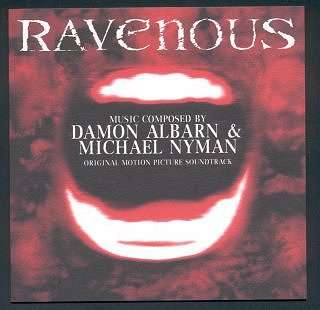
This is initially a somewhat daunting album: three of the first four tracks
are out-of-tune. They are source cues, featuring the deliberately and comically
bad playing of either traditional American tunes, or music in a similar idiom,
by an on-screen band. A less uncompromising album would have tucked these
tracks away at the end, or more likely left them off altogether. Quite what
an unsuspecting customer who goes into their local record shop and, having
enjoyed Michael Nyman's soundtrack to The Piano, asks to listen to
this album will think is anyone's guess! The comedic cinematic potential
for embarrassingly bad musicianship is well known, but without the visuals
the joke obviously doesn't really work.
Even when we reach the score 'proper', it is still presents quite a challenge.
There is over an hour-and-a-quarter of music, and it carries the disorientating
shock of the new, such that it may take many listens to begin to formulate
an opinion of the disc. This is quite a heartening achievement, that still
in 1999 a film score can sound new and fresh and really not like anything
which has gone before, though perhaps it is not surprising that a
gothic-black-comedy-horror-cannibal-Western should have a distinctive musical
accompaniment.
Clearly this is a most unusual collaboration, and it appears to be a genuine
partnership of equals. On the front cover the music is credited to Damon
Albarn & Michael Nyman, while on the back cover the names are in reverse
order. Approaching this from a film music point-of-view, Nyman is obviously
the major name: this does not sound particularly like a Michael Nyman score.
There are some familiar elements, some of the composer's famed minimalist
repetition and predilection for string textures, but overall this is a denser,
darker and more intense work than anything I have previously heard from Michael
Nyman. That said, this sounds even less like a Damon Albarn album. Albarn,
for those who do not know, is the lead singer with the very successful rock
band Blur. He made his film acting debut with a small role in director Antonia
Bird's previous film, Face, and now has been promoted to her co-composer.
Whatever his contribution to Ravenous, and he is credited in addition
to composing, with co-production (with Nyman) and 'Additional sequenced
orchestrations', he has not brought Blur to the cinema with him.
'Boyd's Journey' The first part of the score 'proper' opens with a single
repeated plucked note on a banjo, then is joined by a drum, and a simple
but very memorable melody on squeeze-box. There is a plaintive, resigned
and lonely quality to the theme, which will recur throughout the score. A
slow and dark minimalism stalks through 'Stranger at the Window', setting
the tone for much of the following music.
Things really start to come together with 'Colquhoun's Story'. Over what
appears to be a loop of part of 'Boyd's Journey', more and more layers of
instrumental colour are added. First a sharp plucked steel guitar, then flute,
eventually building to the powerful entry of massed strings. The piece continues
to grow in vertiginous circling fashion, acquiring great dramatic power until
the fade. 'Trek to the Cave' is more conventional, offering lush strings
and writing in a vein similar to Nyman's The Piano Concerto (without
the piano), but ends with an explosion of frenetic violence.
'The Cave' is, at 8 minutes, one of the central tracks of the score. Opening
as a strange ambient soundscape of bells, drums and an unidentifiable 'strange
sound', at least part of which is synthesised, the writing changes to suspenseful
harp arpeggios, dissonant strings and uneasy piano notes. Over unstoppable
percussion the piece climbs to a fever-pitch of furious dark malevolence,
such that the jaunty little dance for fiddle and banjo which follows is quite
a relief. The respite is short-lived: '"Let's Go Kill that Bastard"' is another
suspense cue of tremendous cumulative power, again involving implacable
percussion, but this time adding a solo violin and what appear to be marimbas.
'"The Pit"' is almost an off-kilter carousel theme. The ghost of Bernard
Herrmann seems to be offering his approval to this elegant, lugubrious
intermission. Darker territories call, and a force of destiny drives the
musical narrative along to the epic 'Saveoursoulissa'. A drum echoes over
what sounds like a record-player stuck in a groove, complete with surface
noise. A distant resonant electronic voice growls as it rises and falls,
and a wordless (sampled?) female voice floats above a rattling cimbalom.
As other sounds enter the soundscape obtains staggering power, creating a
sense of utter desperation and inevitable destruction. This is a stark, gothic
piece closer to something by early 90's 'goth-rock' band The Fields of the
Nephilim than any conventional film music, the climactic chants lending this
a chill power as unsettling as Jerry Goldsmith's The Omen.
There are three more tracks on the album, though not yet having seen the
film, I can not comment as to if they are part of the score, or bonus tracks
created for the album. The latter seems more likely, as they draw on material
already heard, but contain more overt electronic elements as a result of
'additional production and mix' by William Orbit. 'Boyd's Beauty pt.A' is
an ambient version of 'Boyd's Journey', raising the question, what happened
to pt.B? 'Screech Jam' is a furious nightmare, and might work very well in
a horror film context, but is almost too intense for separate listening.
Nevertheless, the production and mixing are extremely accomplished. Finally,
'The Pit' is a distorted mix of the previous piece of the same title, processed
with considerable amounts of electronic reverb to the extent that all the
icy beauty of the piece is transformed into a surreal, dreamlike waltz to
which almost any reaction is possible. I honestly do not know if I like it
or not, yet it is undeniably entrancing.
75 minutes later, the effect is… overwhelming, exhausting, breathtaking.
Two very different and distinctive musicians have together produced something
utterly unexpected. This is extraordinary film music and a remarkable album.
Such is the intensity of the experience that I am not sure that I will want
to listen to it all that often, but now that I have the album I would not
want to be without it. Some will love this, others detest it. Few will be
indifferent. It is that rare thing, a work which continues the more experimental
traditions of film music to create something new and original, and it may
be that it will take some years before the worth of this score can really
be assessed. Even so, come December, I am certain it is going to be accounted
one of the most important works of the year.
Reviewer
Gary S. Dalkin


